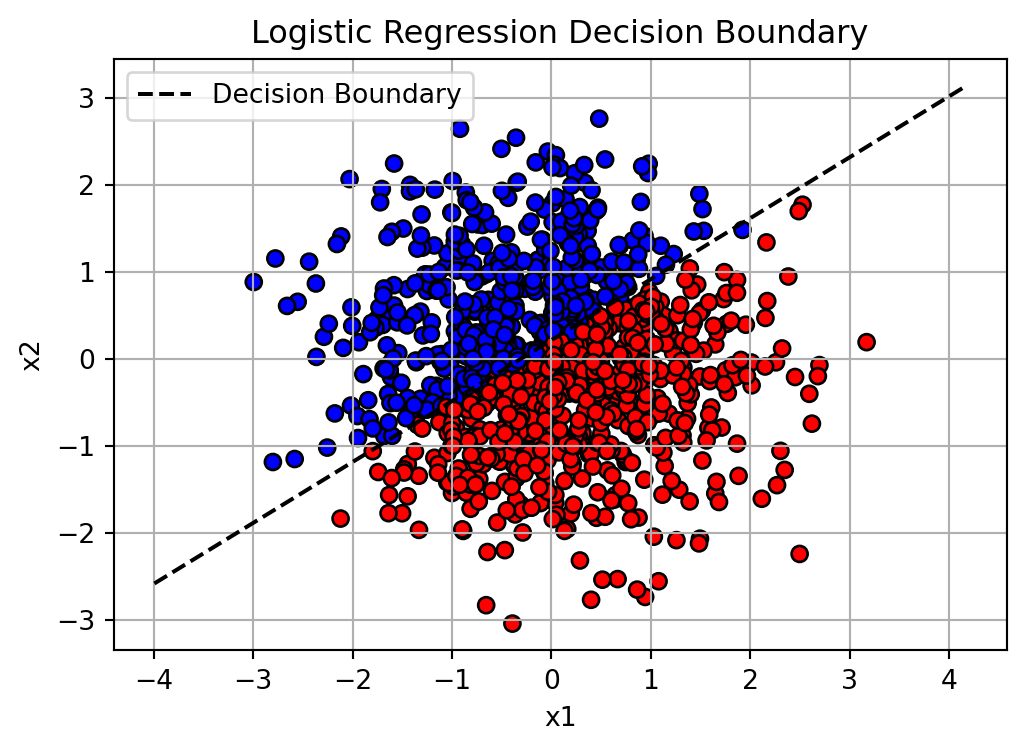Logistic Regression Model
The logistic regression model estimates the probability of the label \(y\) given the input \(x\) by:
\[
\mathbb{P}(y = 1) = \sigma(w^\top x + b)
\]
Here:
- \(x \in \mathbb{R}^d\) is the input vector, \(y \in \{0, 1\}\) is the binary label
- \(w \in \mathbb{R}^d\) is the weight vector, \(b \in \mathbb{R}\) is the bias (intercept)
- \(\sigma(z) = \dfrac{1}{1 + e^{-z}} = \dfrac{e^z}{1 + e^z}\) is the sigmoid function
Binary Cross-Entropy Loss
The loss function we minimize is the binary cross-entropy:
\[
L(w, b) = -\frac{1}{n} \sum_{i=1}^n \left[ y_i \log(\hat{y}_i) + (1 - y_i) \log(1 - \hat{y}_i) \right]
\]
Here:
- \(n\) is the number of training examples
- \(y_i\) is the true label for the \(i\)-th sample
- \(\hat{y}_i = \sigma(w^\top x_i + b)\) is the predicted probability
Intuition
- If \(y_i = \hat{y}_i = 1\) for all \(i\), the loss is 0 — perfect prediction.
- If \(y_i = \hat{y}_i = 0\) for all \(i\), the loss is also 0.
- If \(y_i = 1\), \(\hat{y}_i = 0\), the loss becomes infinite — the worst-case prediction.
Deriving the Gradient
We start with the individual loss for each sample:
\[
L_i = -\left[ y_i \log(\sigma(z_i)) + (1 - y_i) \log(1 - \sigma(z_i))
\right],
\]
where \(z_i = w^\top x_i + b\). Using the identity \(\frac{d\sigma(z)}{dz} = \sigma(z)(1 - \sigma(z))\), we obtain the gradient:
\[\begin{align*}
\frac{\partial L_i}{\partial z_i}
&= -\left[ y_i \frac{1}{\sigma(z_i)} \frac{\partial \sigma(z_i)}{\partial z_i} + (1 - y_i) \frac{-1}{1 - \sigma(z_i)} \frac{\partial \sigma(z_i)}{\partial z_i} \right]\\
&= -\left[ y_i \bigl(1 - \sigma(z_i)\bigr) - (1 - y_i) \sigma(z_i) \right]\\
&= \sigma(z_i) - y_i\\
&= \hat{y}_i - y_i.
\end{align*}\]
By the chain rule, we can compute the gradient of the loss w.r.t. the weights \(w\) and bias \(b\): \[\begin{align*}
\frac{\partial L_i}{\partial w} &= \frac{\partial L_i}{\partial z_i} \cdot \frac{\partial z_i}{\partial w} = (\hat y_i - y_i) x_i,\\
\frac{\partial L_i}{\partial b} &= \frac{\partial L_i}{\partial z_i} \cdot \frac{\partial z_i}{\partial b} = (\hat y_i - y_i).
\end{align*}\]
Averaging over all \(n\) samples,the gradients become:
\[\begin{equation}
\frac{\partial L}{\partial w} = \frac{1}{n} \sum_{i=1}^n (\hat{y}_i - y_i) x_i
\quad \text{ and } \quad
\frac{\partial L}{\partial b} = \frac{1}{n} \sum_{i=1}^n (\hat{y}_i - y_i).
\end{equation}\]
Step 1: Data Generation
import numpy as np
import matplotlib.pyplot as plt
np.random.seed(0)
n, d = 1000, 2
X = np.random.randn(n, d)
true_w = np.array([2.0, -3.0])
bias = 0.5
logits = X @ true_w + bias
probs = 1 / (1 + np.exp(-logits))
y = (probs > 0.5).astype(np.float32)
plt.scatter(X[:, 0], X[:, 1], c=y, cmap='bwr', edgecolor='k')
plt.title("Synthetic Binary Classification Data")
plt.xlabel("x1")
plt.ylabel("x2")
plt.grid(True)
plt.show()
Step 2: Logistic Regression with NumPy
def sigmoid(z):
return 1 / (1 + np.exp(-z))
def binary_cross_entropy(y_true, y_pred):
eps = 1e-7
return -np.mean(y_true * np.log(y_pred + eps) + (1 - y_true) * np.log(1 - y_pred + eps))
w = np.zeros(2)
b = 0.0
lr = 0.1
for epoch in range(100):
z = X @ w + b
y_pred = sigmoid(z)
loss = binary_cross_entropy(y, y_pred)
dz = y_pred - y
dw = X.T @ dz / n
db = np.mean(dz)
w -= lr * dw
b -= lr * db
if epoch % 10 == 0:
print(f"Epoch {epoch}, Loss: {loss:.4f}")
# Plotting the decision boundary
x_min, x_max = X[:, 0].min() - 1, X[:, 0].max() + 1
x_vals = np.linspace(x_min, x_max, 100)
# Solve for x2 on the decision boundary line: w1*x1 + w2*x2 + b = 0
# => x2 = -(w1*x1 + b)/w2
y_vals = -(w[0] * x_vals + b) / w[1]
# Plot
plt.figure(figsize=(6, 4))
plt.scatter(X[:, 0], X[:, 1], c=y, cmap='bwr', edgecolor='k')
plt.plot(x_vals, y_vals, 'k--', label='Decision Boundary')
plt.title("Logistic Regression Decision Boundary")
plt.xlabel("x1")
plt.ylabel("x2")
plt.legend()
plt.grid(True)
plt.show()
Epoch 0, Loss: 0.6931
Epoch 10, Loss: 0.5710
Epoch 20, Loss: 0.4932
Epoch 30, Loss: 0.4403
Epoch 40, Loss: 0.4019
Epoch 50, Loss: 0.3726
Epoch 60, Loss: 0.3495
Epoch 70, Loss: 0.3305
Epoch 80, Loss: 0.3147
Epoch 90, Loss: 0.3013
Step 3: Logistic Regression with PyTorch
import torch
from torch import nn
X_tensor = torch.tensor(X, dtype=torch.float32)
y_tensor = torch.tensor(y, dtype=torch.float32).view(-1, 1)
model = nn.Sequential(
nn.Linear(d, 1),
nn.Sigmoid()
)
loss_fn = nn.BCELoss()
optimizer = torch.optim.SGD(model.parameters(), lr=0.1)
for epoch in range(100):
model.train() # set model to training mode
# step 1: make prediction (forward pass)
y_pred = model(X_tensor)
# step 2: compute loss
loss = loss_fn(y_pred, y_tensor)
# step 3: clear old and compute current gradients
optimizer.zero_grad() # clear old gradients
loss.backward() # compute current gradients
# step 4: update parameters
optimizer.step()
if epoch % 10 == 0:
print(f"Epoch {epoch}, Loss: {loss.item():.4f}")
Epoch 0, Loss: 0.6921
Epoch 10, Loss: 0.5684
Epoch 20, Loss: 0.4893
Epoch 30, Loss: 0.4356
Epoch 40, Loss: 0.3970
Epoch 50, Loss: 0.3678
Epoch 60, Loss: 0.3449
Epoch 70, Loss: 0.3263
Epoch 80, Loss: 0.3108
Epoch 90, Loss: 0.2977

